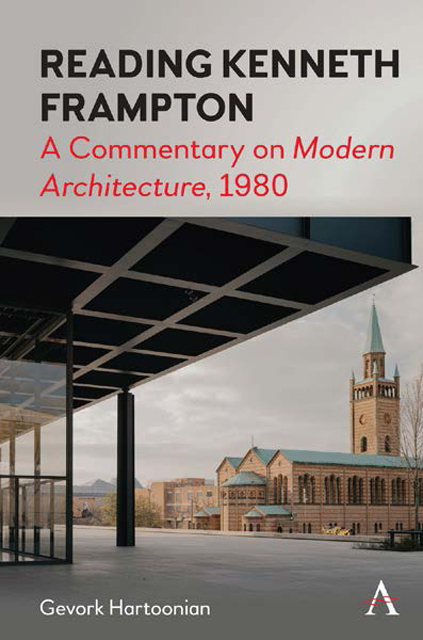5 - The Agency of the Critical
Published online by Cambridge University Press: 09 December 2022
Summary
Preamble
Starting with the cover page of part III of Kenneth Frampton's A Critical History (1980), this chapter proceeds to unpack the semantics of the title of the last part of the book, “Critical Assessment and Extension into the Present 1925–78,” a period ending two years before the publication of the first edition of the book. The argument presented in this chapter benefits from the cover page of part III of the book, a photo of the Willis-Faber & Dumas Building by Foster Associates (1974) (Figure 5.1). The chosen angle of the daytime image of this project draws attention: Was it intended to mirror the building's surroundings on the surface cladding at the expense of masking the architecture's vitality? However, like an X-ray, the nighttime image of the same project reveals the building's skeleton. The dual representative nature of these two images suggests a critique of postmodern architecture wherein quotations from historical languages camouflage the building's structural system. On the other hand, the daytime image highlights an atectonic interpretation of Miesian steel and glass architecture. Considering Frampton's definition of the “product-form,” the dual nature of the coverpage image suggests the decline of craft in favor of utilizing a Taylorized process of making that had been in the mind of modernists as early as the 1920s. We are reminded of Walter Gropius's Torten Seidlung Dessau (1926– 28), among other examples, that Frampton enumerates in another manuscript where he unpacks the concept of product-form. The title and the suggested two interrelated readings of the cover-page image set the stage for the present exploration of the themes and architects discussed in the four chapters compiled in part III of Frampton's book. Special attention will be focused on several works necessary for the stakes involved in postwar architecture and on how Frampton's analysis sharpens his critical agenda. The discussion begins with chapter 4, “Place, Production, and Architecture: Towards a Critical Theory of Building.” This chapter reads like a postscript to “Mies contra Aalto conundrum” and a prelude to Frampton's signature essay “Critical Regionalism,” much discussed then and now. These two subjects are discussed in the last two chapters of the present volume.
- Type
- Chapter
- Information
- Reading Kenneth FramptonA Commentary on 'Modern Architecture', 1980, pp. 105 - 138Publisher: Anthem PressPrint publication year: 2022

